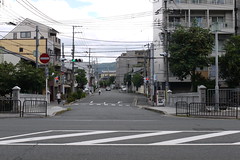 一条戻橋京都
一条戻橋京都The Ichijo Modoribashi ("Bridge of Revival"), which crosses the tiny Horikawa River (canal) in north central Kyoto, is not much to look at. It is one of many small bridges that cross the canal and park that now lines it.
However, the bridge, which was first erected here in 794 C.E. and remains today in the same location, has seen its share of history and mystery.
First, let's look at the history of the bridge. It was used as an execution ground during Japan's horrific civil war, during the 15th and 16th centuries.
In the late 1597, warlord Toyotomi Hideyoshi oversaw an especially morbid sentence here. Prior to exiling twenty-six Catholic missionaries to Nagasaki, he had their ears sliced off at the bridge - and then sent them off on their merry way.
In another episode, the severed head of Sen no Rikyu - the founder of the Japanese traditional tea ceremony - was displayed here following his ritual suicide. (Due to a break with Hideyoshi, Sen no Rikyu was forced to kill himself.)
On the mysterious side, it is rumored that the bridge is a passage to the world of the afterlife.
During the 10th century, just as a well known scholar’s funeral cortege was crossing the bridge, his son joined the procession. The son had not been in time for the funeral and, according to the legend, at this moment the corpse of the father came to life for just long enough to bid his son farewell.
During the 10th century, just as a well known scholar’s funeral cortege was crossing the bridge, his son joined the procession. The son had not been in time for the funeral and, according to the legend, at this moment the corpse of the father came to life for just long enough to bid his son farewell.
And thus the name. The Bridge of Revival is named for the above incident in which the father, who revived, if ever so briefly, to meet his son one last time.
Something to keep in mind the next time we are cycling across the bridge.
 © CycleKyoto.com
© CycleKyoto.comTags
Japan
Touring
Kyoto
Cycle
Ichijo Modoribashi
No comments:
Post a Comment